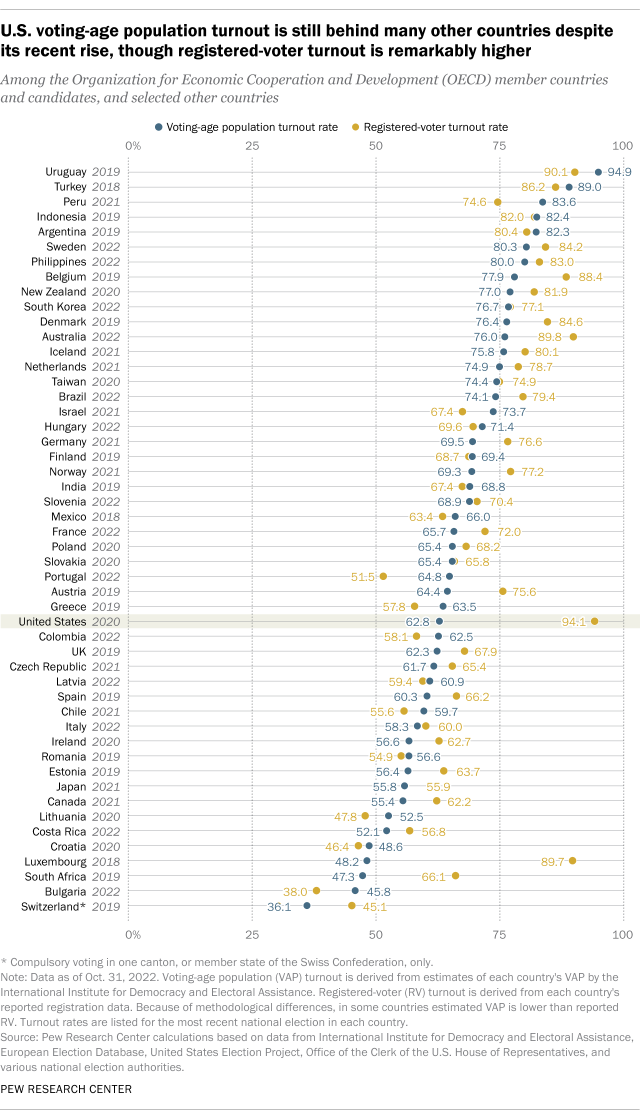
Voter turnout in the 2020 U.S. general election soared to levels not seen in decades, fueled by the bitter campaign between Joe Biden and Donald Trump and facilitated by pandemic-related changes to state election rules. More than 158.4 million people voted in that election, according to a Pew Research Center tabulation of official state returns, amounting to 62.8% of people of voting age, using Census Bureau estimates of the 2020 voting-age population.
The 2020 voting surge followed unusually high turnout in the 2018 midterm elections, when about 47.5% of the voting-age population – and 51.8% of voting-age citizens – went to the polls.
This year, some political analysts are predicting another heavy turnout in this month’s midterms. According to a recent Center survey, 72% of registered voters say they’re “extremely” or “very” motivated to vote this year, and 65% say it “really matters” which party wins control of Congress – a level roughly on par with the run-up to the 2018 vote.
As the 2022 midterm elections draw near, Pew Research Center decided to revisit its occasional comparisons of U.S. turnout rates with those of other countries.
For our comparison group, we began with the 37 other countries in the Organization for Economic Cooperation and Development (OECD), a group of mostly highly developed, mostly democratic states. For greater diversification, we added to that group the six current candidates for OECD membership (Argentina, Brazil, Bulgaria, Croatia, Peru and Romania), as well as six other economically significant electoral democracies (India, Indonesia, the Philippines, South Africa, Taiwan and Uruguay), for an even 50 countries.
Political scientists often define turnout as votes cast divided by the estimated number of eligible voters. But eligible-voter estimates are difficult or impossible to find for many nations. So to compare turnout calculations internationally, we used two different denominators – the estimated voting-age population and the total number of registered voters, because they’re readily available for most countries.
Using both denominators, we calculated turnout rates for the most recent national election in each country as of Oct. 31, 2022, except in cases where that election was for a largely ceremonial position (such as president in a parliamentary system) or for European Parliament members, as turnout is often substantially lower in such elections. In countries that elect both a legislature and a head of state, we used the election that attracted the most voters. Voting-age turnout is based on estimates of each country’s voting-age population (VAP) by the International Institute for Democracy and Electoral Assistance (IDEA). Registered-voter turnout is derived from each country’s reported registration data. (In some countries, IDEA’s VAP estimates are lower than the reported number of registered voters due to methodological differences.)
For most countries, we gathered vote totals from national election authorities or statistical agencies. For the U.S., which has no central elections authority, we compiled the total votes cast in the 2020 presidential election from each state’s election office, and checked them against figures compiled by the Office of the Clerk of the U.S. House of Representatives (read more about the methodology). We also drew data on reported registrations from the U.S. Census Bureau.
One unknown factor, though, is how the many state voting-law changes since 2020 will affect turnout. While some states have rolled back early voting, absentee or mail-in voting, and other rule changes that made voting easier in 2020 – or adopted new rules that make voting more difficult or inconvenient – other states have expanded ballot access.
Even if predictions of higher-than-usual turnout come to pass, the United States likely will still trail many of its peers in the developed world in voting-age population turnout. In fact, when comparing turnout among the voting-age population in the 2020 presidential election against recent national elections in 49 other countries, the U.S. ranks 31st – between Colombia (62.5%) and Greece (63.5%).

The Center examined the most recent nationwide election results for 50 countries, mostly with highly developed economies and solid democratic traditions. The clear turnout champion was Uruguay: In the second, decisive round of that nation’s 2019 presidential election, 94.9% of the estimated voting-age population and 90.1% of registered voters cast ballots.
Uruguay’s voting-age turnout was followed by Turkey (89% in the 2018 presidential election) and Peru (83.6% in last year’s presidential election). All five countries with the highest voting-age turnout have presidential, as opposed to parliamentary, systems of government, and four of the five have – and enforce – laws making voting compulsory.
In Switzerland, by contrast, just 36.1% of the voting-age population turned out in the 2019 parliamentary elections, the lowest among the 50 countries in our analysis. But that may have less to do with voter apathy than with demographics: More than a quarter of Switzerland’s permanent resident population (25.7%) are foreign nationals, and hence ineligible to vote in Swiss elections.
When turnout is calculated as a share of registered voters, Swiss turnout rises to 45.1% – still the second-lowest among the 50 countries we examined. In Luxembourg, by comparison, changing the metric makes a dramatic difference: The tiny country’s voting-age turnout was just 48.2% in its 2018 parliamentary election, but 89.7% of registered voters went to the polls. Why? Nearly half of the population (47.1%) are foreigners.
Those examples illustrate how turnout comparisons between countries are seldom clean and often tricky. Another complicating factor, besides demographics, is how countries register their voters.
In many countries, the national government takes the lead in getting people’s names on the voter rolls – whether by registering them automatically once they become eligible (as in, for example, Sweden or Japan) or by aggressively encouraging them to do so (as in the United Kingdom). In such countries, there’s often little difference in turnout rates among registered voters and the voting-age population as a whole.
In other countries – notably the United States – it’s largely up to individual voters to register themselves. And the U.S. is unusual in that voter registration is not the job of a single national agency, but of individual states, counties and cities. That means the rules can vary considerably depending on where a would-be voter lives.
It also means there’s no single, authoritative source for how many people are registered to vote in the U.S. The Census Bureau estimates that in 2020, 168.3 million people were registered to vote in 2020 – or at least said they were. Even so, that figure represents only about two-thirds of the total voting-age population (66.7%) and 72.7% of citizens of voting age. By comparison, 91.8% of the UK’s voting-age population was registered to vote in that country’s 2019 parliamentary election; the equivalent rates were 89.1% in Canada, 94.1% in New Zealand and 90.7% in Germany for those countries’ most recent national elections.
In the U.S., there’s a huge gap between voting-age turnout (62.8% in 2020) and registered-voter turnout (94.1% that same year). In essence, registered voters in the U.S. are much more of a self-selected group than in other countries – already more likely to vote because, in most cases, they took the trouble to register themselves.

Some states are trying to reduce that gap. As of this past January, 19 states and the District of Columbia automatically register people to vote (unless they opt out) when they interact with the state motor vehicles department or other designated state agencies. Three other states are on track to fully implement automatic registration in the next few years. And North Dakota doesn’t require voter registration at all.
Another complicating factor for cross-national turnout comparisons: According to the International Institute for Democracy and Electoral Assistance (IDEA), 27 countries (and one Swiss canton, or member state of the Swiss Confederation) have laws making voting compulsory, including 12 of the 50 countries examined here. Overall, 14 of those 27 countries actively enforce their laws, with penalties including fines, inability to access certain public services, or even imprisonment.
How much difference such laws make is unclear. On the one hand, four of the five countries with the highest turnout rate (whether measured as a share of the total voting-age population or of registered voters) have and enforce such laws. In the eight countries examined that enforce compulsory-voting laws, voting-age turnout averaged 78.2% in the most recent election, compared with 57.6% in the four countries that have such laws on the books but don’t actively enforce them. But in the remaining 38 countries and Switzerland, which have no national compulsory-voting laws, turnout averaged 65%.
Although there aren’t many examples, there’s some indication that too many elections in too short a time can dampen voters’ enthusiasm. Consider Bulgaria, which has had four parliamentary elections in the past 18 months, as the leading parties have repeatedly tried and failed to form a stable governing coalition. Turnout was 58.3% of voting-age Bulgarians in the first election (April 2021), but steadily fell to 45.8% in the most recent one (45.8% earlier this month). And with a splintered parliament as yet unable to agree on a new government, weary Bulgarians may yet have to trudge back to the polls sooner rather than later.
Israelis had to go the polls four times between April 2019 and March 2021 before lawmakers were able to agree on a governing coalition; turnout among voting-age Israelis rose from 74.6% in the first election to 77.9% in the third, before falling back to 73.7% in the March 2021 vote. But the coalition that emerged nearly three months after that election fell apart barely a year later, and Israel is holding yet another election today, Nov. 1.



